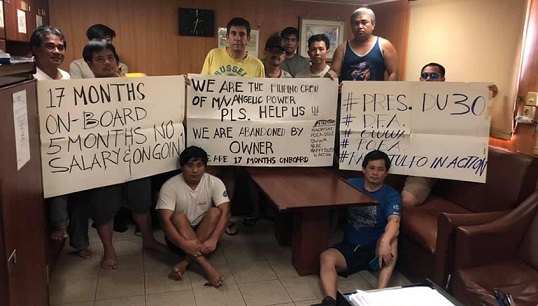
The International Chamber of Shipping (ICS), International Maritime Organization (IMO) and International Transport Workers ' Federation (ITF) are concerned with the growing problem of crew abandonment, which leaves hundreds of seafarers trapped aboard, sometimes for years. Rob Coston reports
International organisations are expressing concern about the rise in cases of crew abandonment worldwide during the Covid-19 pandemic.
Although abandonment has long been a scourge, figures collected recently show that it has been worsened by the pandemic.
The International Transport Workers' Federation (ITF) maintains a database of abandonment cases. According to the ITF, the number of ship abandonments the organisation is dealing with has more than doubled since the start of the pandemic, from 40 cases on the database 2019, to 85 in 2020. The scale of the problem becomes clear when it is understood that these 85 cases involved more than 1,300 seafarers. The problem is also worldwide, with cases from China to the UAE to Italy.
A further 28 cases have been added in 2021. ITF Inspectorate coordinator Steve Trowsdale warns that these officially reported cases are just 'the tip of the iceberg', with many more going unreported.
The International Chamber of Shipping (ICS) reported in June that it has been involved in the repatriation of more than 100 seafarers during the past two years.
Meanwhile, in collaboration with the International Labour Organisation (ILO), the International Maritime Organisation (IMO) maintains a database of cases of abandonment involving seafarers (the ITF database also feeds into this).
In the IMO Legal Committee session from 26-30 July 2021, delegates noted the alarming increase in the number of abandoned seafarers added to the database. From 1 January 2020 to 1 April 2021, 111 new cases had been reported. The 85 cases in 2020 had already set a record high, but an additional 26 cases were added in the first quarter of 2021.
On 26 July when the committee met, of the 111 new cases, only 43 had been resolved. Another 27 were added in the second quarter of 2021, continuing the disastrous trend.
Living up to responsibilities
Organisations examining the problem have found that it is often related to a failure on the part of nations worldwide to fulfil their obligations to seafarers – both legal and moral.
'Abandonment is on the rise, and sadly a reason for that rise has been flag states not living up to their responsibilities to seafarers,' said Mr Trowsdale. 'Flag states are supposed to ensure that ships that fly their flags are paying seafarers on time, repatriating them at the end of contracts, and providing the necessities of life.'
The flag of convenience system does seem to be a major contributing factor. The ICS has identified an issue over the past year with flag states that have not ratified the Maritime Labour Convention (MLC), which guarantees basic rights for seafarers and mandates that shipowners have insurance to cover abandonment. Many of the recent cases are related to vessels registered in these countries, especially Ukraine, Cameroon, Bahrain, and Bolivia.
However, other countries that do have reputable flags and are signatories to the MLC have also been condemned for failing to live up to their obligations. These countries include India, which has the largest number of abandoned seafarers, and Panama, which had the largest number of cases of ship abandonment in the past year.
Information is vital
The IMO Legal Committee emphasises that keeping the abandonment databases up to date is vital to tackling this growing problem. It encourages member states to report incidents of abandonment to the database when they occurred in their ports or on vessels flying their flag; and to further ratify and effectively implement the Maritime Labour Convention (MLC, 2006).
Nautilus members can assist in this process. Various stakeholder organisations at the International Maritime Organisation (IMO) can report a case of abandonment if they are informed that it has taken place. This including flag states, and NGOs with consultative or observer status.
According to the 2001 IMO/ILO Guidelines, abandonment is characterised by the severing of ties between the shipowner and seafarer.
This occurs when the shipowner fails to fulfil fundamental obligations to the seafarer regarding timely repatriation, payment of outstanding wages, and provision of the basic necessities of life (e.g. food, accommodation, and medical care). Abandonment is considered to have taken place when the master has been left without the financial means to operate the vessel.
If you suspect a ship has been abandoned, you should contact ITF Seafarer Support. The ITF will then log the incident in its own database and report it to the IMO.
Recent abandonment cases
- Mohammad Aisha spent four years aboard the abandoned Bahrain-flagged MV Aman in the Suez Canal while the vessel waited to be sold, due to Egypt’s legal guardianship system. He finally returned home on 22 April
- The crew of the Eide Trader were abandoned during 2020 by their employer at Sharjah Port, UAE. Five crew members were kept on board by authorities. On 11 February the five remaining crew members were able to go home
- Nine Greek and 15 Filipino crew were trapped aboard the bulk carrier MV Angelic Power at Guangzhou, China, for up to 17 months. The ship owner abandoned the vessel, and the insurance which would have paid for repatriation had expired. Following a legal battle, the last crew members were finally repatriated on 21 July, after 17 months on the ship
- 25 crew aboard the MV Ula were abandoned in 2019 when the owner stopped paying their wages and providing food, fuel and water. Their ordeal included a mutiny, hunger strike and being detained aboard by Kuwaiti authorities due to Covid-19. The final seafarers are returning home thanks to IMO, ILO and ITF intervention, with one having been trapped aboard for 31 months.
Tags
